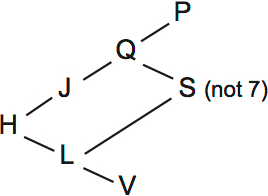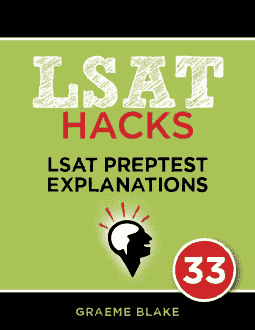This is an explanation of the first logic game from Section IV of LSAT Preptest 33, the December 2000 LSAT.
Seven TV programs (H, J, L, P, Q, S, V) were given rankings from first to seventh. The game’s rules allow you to determine possible orders for the programs.
Game Setup
This is a pure sequencing game (sometimes called “ordering”). It’s the easiest type of game to master. Once you can do one, you can do all of them.
Generally, all of the rules can be combined into one large diagram. Start with one rule, and add each one on to the diagram.
Note that “most popular” is on the left. This diagram shows that H is more popular than J and L.

The next rule can go directly on the diagram. J is more popular than Q:

I’m drawing Q going up rather than down because I read all of the rules and foresaw that everything fits together better this way. Rules 3 and 4 show that S comes after both L and Q, so I want to be able to fit that in.
You must read the diagram left to right. If two variables are connected by lines running left to right, then one is before the other. So H is before Q, but L isn’t necessarily before J. No lines connect J or L.
Here I’ve added rules 3, 4 and 5 to the diagram. P is after Q. V is after L, S is after L and Q, and S is not 7th.


Want a free Logic Games lesson?
Get a free sample of the Logic Games Mastery Seminar. Learn tips for going faster at logic games


Leave a Reply